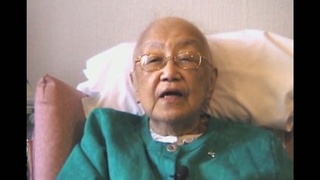In the boat on the way to Brazil (Japanese)
(Japanese) So next, what's it called. I had some toys on the boat with me. I was playing with some toys I bought. There was nobody waiting in the room for me anyway-I didn't know anyone on the boat. Well, there was this one person from my town, so she was nice and looked after me. And the ship's crew-I got to know them well, made some friends, so I was the only one on the boat that got to eat some great food [with them]. Just like that (laughs). I came to Brazil like that, and I was very happy. Of course, when it came time to part with my parents, it was a little tough. But once I started walking on my way, I forgot all about it (laughs).
Date:
Location: Brazil
Contributed by: Caminho da memória - 遥かなるみちのり. São Paulo, Brazil: Comissão de Elaboração da História dos 80 Anos de Imigração Japonesa no Brasil, 1998. VHS.












